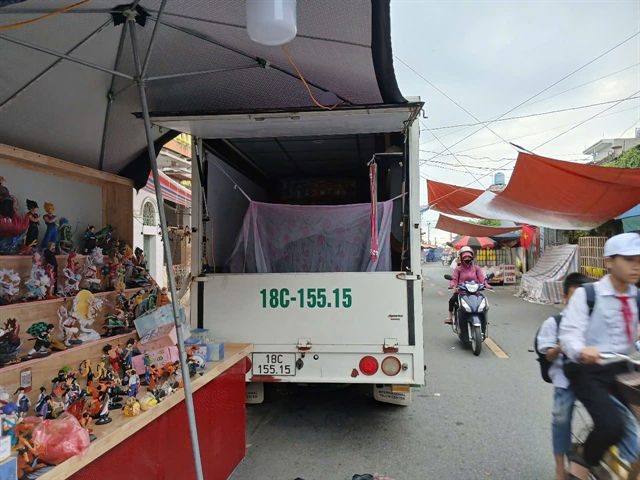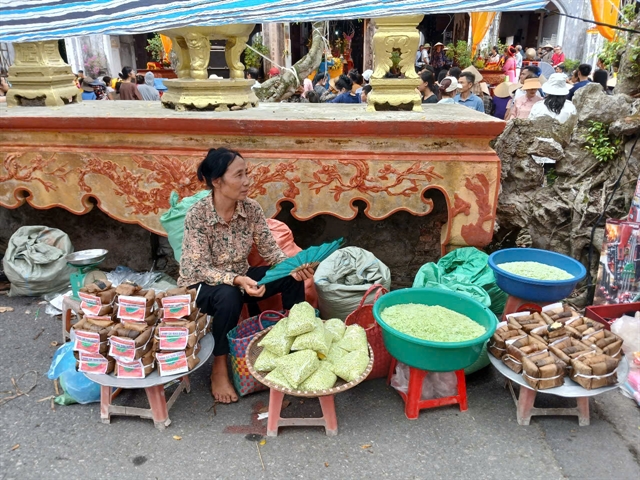Weather:
- Ha Noi 33oC
- Da Nang 33oC
- Ho Chi Minh 32oC

by Minh Hằng
As the ceremonial drumbeats echoed from the communal house in Đồng Xâm Village, Kiến Xương District, Thái Bình Province, village elders were seen adjusting their traditional attire in preparation for the incense offering ritual.
Meanwhile at the village entrance, vendors set up makeshift stalls, displaying snacks and sweets in bamboo trays and gleaming silver trinkets.
Amid the festive blare of horns in the village, with over six centuries of gold and silver engraving craft, another, quieter rhythm pulsed beneath the celebration - the steady and unspoken perseverance of lives bound to the trade.
These are not pilgrims, but peddlers. For these people, the annual festival at Đồng Xâm, from the first to the third day of the fourth lunar month, is more than a cultural celebration. It is a sacred occasion to pay tribute to their ancestors, in keeping with the Vietnamese tradition of uống nước nhớ nguồn, or “when drinking water, remember its source”.
The festival pays tribute to those who built the Đồng Xâm temple complex and helped shape the village’s rich legacy. It is also a time to return, reconnect, and reminisce with old friends over a cup of tea or a packet of cookies.
But for others, the festival season is a vital livelihood.
Many vendors come from nearby districts, while others arrive from as far afield as Hưng Yên, Hà Nam, Hải Dương or Bắc Ninh provinces. They live by selling goods in village festivals in the north from January to April.
“From the first to the fourth lunar months, I go from one festival to another,” said Hưng, 34, from Nam Định, who runs a sugarcane juice stall.
“Some days I make VNĐ300,000 (US$11), other days I barely cover the cost of the stall, or even end up at a loss. But it’s this daily grind that helps keep my two children in school.”
He pointed towards a makeshift market at the entrance of the village selling snacks, candy, plastic toys, figurines made from rice dough on bamboo sticks, fake jewellery, and even miniature silver artworks. It is a temporary marketplace, yet for many, a crucial source of income.
While rituals unfolded within the communal house with drumbeats, dragon dances and incense rites, outside, the marketplace roared to life.

'Always on wheels'
Nguyễn Thị Hương and her husband, from Hà Nội’s Mỹ Đức District, have spent over a decade selling traditional confections like peanut and sesame candies at festivals nationwide. Their furthest journey has been to Quảng Nam Province.
At Đồng Xâm village festival, their candy stall is a regular draw, not just for taste, but for the show.
“People like watching us make the candy there,” Hương said. “They can taste before they buy.”
Their livelihood is seasonal and gruelling.
“We live out of our big van for a few months of the year,” she said. “Mostly, from the first to the fourth lunar month, we’re always on wheels. When our children were small, their grandparents had to take care of them. Now they’re older and could manage themselves. Luckily, they’re hardworking students.”
The couple’s van was stuffed with sacks of materials like sugar, malt, peanuts, sesame, and flour, confectionery and toys.
Festivals like Hương Pagoda near their hometown have been the most profitable, saving on accommodation and transport.
“Some days we use 15 to 20 kilograms of peanuts just to meet demand,” she said. “It’s exhausting, but we are happy to make some profit.”
To stay competitive, they added roasted chestnuts and chestnut-filled cakes this year.
“Just peanut candy wouldn’t attract enough people any more,” Hương said. “We’re known here, so our business has been somewhat more favourable, but this year’s festival hasn’t brought as many sales as in previous years.
"That van becomes our home, storage and bed all in one. We cook when near a market, eat out if we must. It’s hard, but it feeds us.”

Tiny stall of survival
Next to their stall, Phạm Thanh Hùng, 27, and his cousin from Hưng Hà District in Thái Bình Province offered the same chestnut snacks. They had only been trading for two festival seasons, yet the hardship was already setting in.
“There are more stalls with the same goods this year. It’s tough,” he said.
They transported everything by lorry, rented a three-square-metre stall, and stored ingredients with locals.
“At night, we slept in the stall, sealing it with tarpaulin and sleeping on cardboard. It’s not comfortable, but it’s only three days. Better than a daily 20km commute.”
Hùng has sold goods at various village festivals, but finds it easiest to sell at Đồng Xâm.
“Here, people don’t just buy food to eat on the spot. They buy it as gifts for friends, relatives and loved ones. In other provinces, many customers only pick up a little for their own families. So we earn more,” Hùng explained.
Asked why he chooses this path over factory work, Hùng shrugged. “It’s hard, but we like the freedom. Some festivals are good, others not. On average, we make around VNĐ7-8 million a month.”
When not at festivals, they hawk snacks at Thái Bình City’s walking streets. Cao Bằng is the farthest province they have ever travelled to so far.
Among the busiest vendors this year are soft toy sellers. Lê Thị Phương, from Đông Hưng District, runs a booth crammed with stuffed animals. Some are as large as a child or even bigger. Punters throw darts at balloons to win them or pay more to buy directly.
“We’ve done this for over 10 years,” Phương said. “Nearby, we ride motorbikes home at night. Farther away, we sleep in the van.”
Earnings varied wildly. Some days they earned VNĐ500,000-700,000, but rent alone can cost up to VNĐ1 million for three days.
Their eldest son learned plush toy making at a factory, which now supplies their stock. In the off-season, they make toys at home.
Not everyone turns a profit at festival markets, and for many, it’s a struggle just to break even.
Just off to the side of Đồng Xâm communal house, a few vendors from Hải Dương Province had set up small makeshift stalls, selling traditional countryside snacks such as bánh gai, a sticky rice cake made from ramie leaves, green beans and glutinous rice, and puffed rice treats made of young green rice.

Among them was an old woman from Hải Dương, who was taking part in the festival for the first time after hearing about it from a family acquaintance.
“My son sells bánh gai every day in Hải Dương, so I thought I’d bring some here to try my luck,” she said, arranging her goods on a plastic tray.
“But sales are really slow. From morning until noon, I’ve only managed to sell 10 cakes. Today’s just the first day of the festival, but I’m worried they won’t sell and will spoil.”
A Hà Nội resident, Hoàng Thị Hạnh, has relatives in Đồng Xâm Village and returns each year for the festivities. Drawn by the festive atmosphere and the chance to earn a little extra money, she set up a modest fruit juice stall last year in front of her relatives’ home at the entrance to the village.
“In the evening, when the crowd surged, I could barely keep up,” she recalled. “But from morning to noon, I sold only a few cups."
“I was quite busy preparing goods for the three-day festival, but by the end, I only made VNĐ300,000 (US$12).
Hạnh quickly learned the hard condition of rural vending. When prices are set too high, customers shy away, but selling at low price means there’s barely any profit to be made.
“I really feel for those who travel from far away to sell,” she said. “They survive on simple meals and sleep on cardboard or plastic sheets. Earning a living this way is far from easy.”

On the festival’s last night, with all rituals done, vendors dismantled their stalls in the dimming light.
Phương packed push toys into crates and called to her husband, “Hurry up, we have to get back home early to prepare goods for a festival in Hưng Yên Province tomorrow.”
They moved on again, like migrating birds. No one calls them "guardians of heritage", but without them, perhaps the spirit of the village festival would feel just a little less alive. VNS


